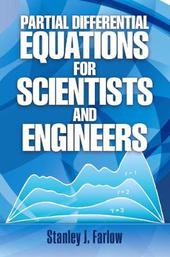
|
Partial Differential Equations for Scientists and Engineers
Paperback / softback
Main Details
| Title |
Partial Differential Equations for Scientists and Engineers
|
| Authors and Contributors |
By (author) Stanley J. Farlow
|
| Series | Dover Books on Mathematics |
|---|
| Physical Properties |
| Format:Paperback / softback | | Pages:414 | | Dimensions(mm): Height 232,Width 20 |
|
| Category/Genre | Maths for scientists
Maths for engineers |
|---|
| ISBN/Barcode |
9780486676203
|
| Classifications | Dewey:515.353 |
|---|
| Audience | |
|---|
|
Publishing Details |
| Publisher |
Dover Publications Inc.
|
| Imprint |
Dover Publications Inc.
|
| Publication Date |
17 March 2003 |
| Publication Country |
United States
|
Description
This highly useful text for students and professionals working in the applied sciences shows how to formulate and solve partial differential equations. Realistic, practical coverage of diffusion-type problems, hyperbolic-type problems, elliptic-type problems and numerical and approximate methods. Suggestions for further reading. Solution guide available upon request. 1982 edition.
Author Biography
Partial Differential Equations & Beyond Stanley J. Farlow's Partial Differential Equations for Scientists and Engineers is one of the most widely used textbooks that Dover has ever published. Readers of the many Amazon reviews will easily find out why. Jerry, as Professor Farlow is known to the mathematical community, has written many other fine texts - on calculus, finite mathematics, modeling, and other topics. We followed up the 1993 Dover edition of the partial differential equations title in 2006 with a new edition of his An Introduction to Differential Equations and Their Applications. Readers who wonder if mathematicians have a sense of humor might search the internet for a copy of Jerry's The Girl Who Ate Equations for Breakfast (Aardvark Press, 1998). Critical Acclaim for Partial Differential Equations for Scientists and Engineers: "This book is primarily intended for students in areas other than mathematics who are studying partial differential equations at the undergraduate level. The book is unusual in that the material is organized into 47 semi-independent lessonsrather than the more usual chapter-by-chapter approach. "An appealing feature of the book is the way in which the purpose of each lesson is clearly stated at the outset while the student will find the problems placed at the end of each lesson particularly helpful. The first appendix consists of integral transform tables whereas the second is in the form of a crossword puzzle which the diligent student should be able to complete after a thorough reading of the text. "Students (and teachers) in this area will find the book useful as the subject matter is clearly explained. The author and publishers are to be complimented for the quality of presentation of the material." - K. Morgan, University College, Swansea
|